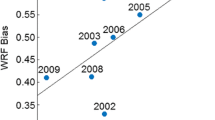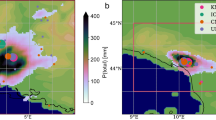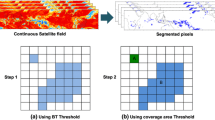Abstract
Object-based algorithm provides additional spatiotemporal information of precipitation, besides traditional aspects such as amount and intensity. Using the Method for Object-based Diagnostic Evaluation with Time Dimension (MODE-TD, or MTD), precipitation features in western Canada have been analyzed comprehensively based on the Canadian Precipitation Analysis, North American Regional Reanalysis, Multi-Source Weighted-Ensemble Precipitation, and a convection-permitting climate model. We found light precipitation occurs frequently in the interior valleys of western Canada while moderate to heavy precipitation is rare there. The size of maritime precipitation system near the coast is similar to the continental precipitation system on the Prairies for moderate to heavy precipitation while light precipitation on the Prairies is larger in size than that occurs near the coast. For temporal features, moderate to heavy precipitation lasts longer than light precipitation over the Pacific coast, and precipitation systems on the Prairies generally move faster than the coastal precipitation. For annual cycle, the west coast has more precipitation events in cold seasons while more precipitation events are identified in warm seasons on the Prairies due to vigorous convection activities. Using two control experiments, the way how the spatiotemporal resolution of source data influences the MTD results has been examined. Overall, the spatial resolution of source data has little influence on MTD results. However, MTD driven by dataset with coarse temporal resolution tend to identify precipitation systems with relatively large size and slow propagation speed. This kind of precipitation systems normally have short track length and relatively long lifetime. For a typical precipitation system (0.7 \(\sim \) 2 \(\times \) 10\(^{4}\) km\(^{2}\) in size) in western Canada, the maximum propagation speed that can be identified by 6-h data is approximately 25 km h\(^{-1}\), 33 km h\(^{-1}\) for 3-h, and 100 km h\(^{-1}\) for hourly dataset. Since the propagation speed of precipitation systems in North America is basically between 0 and 80 km h\(^{-1}\), we argue that precipitation features can be identified properly by MTD only when dataset with hourly or higher temporal resolution is used.










Similar content being viewed by others
References
Ahrens CD (2009) Meteorology today an introduction to weather, climate and the environment (9th). Pacific Grove, CA
Bailey WG, Oke TR, Rouse W (1997) Surface climates of Canada, vol 4. McGill-Queen’s Press, Montreal
Barry RG, Chorley RJ (2009) Atmosphere, weather and climate. Routledge, Abingdon
Beck HE, Wood EF, Pan M, Fisher CK, Miralles DG, van Dijk AI, McVicar TR, Adler RF (2019) Mswep v2 global 3-hourly 0.1 precipitation: methodology and quantitative assessment. Bull Am Meteorol Soc 100(3):473–500
Bonsal B, Zhang X, Hogg W (1999) Canadian prairie growing season precipitation variability and associated atmospheric circulation. Clim Res 11(3):191–208
Bukovsky MS, Karoly DJ (2007) A brief evaluation of precipitation from the north american regional reanalysis. J Hydrometeorol 8(4):837–846
Bullock R, Brown B, Fowler T (2016) Method for object-based diagnostic evaluation. Tech Rep. https://doi.org/10.5065/D61V5CBS
Cai H, Dumais RE Jr (2015) Object-based evaluation of a numerical weather prediction model’s performance through forecast storm characteristic analysis. Weather Forecast 30(6):1451–1468
Carbone R, Tuttle J, Ahijevych D, Trier S (2002) Inferences of predictability associated with warm season precipitation episodes. J Atmos Sci 59(13):2033–2056
Chen F, Dudhia J (2001) Coupling an advanced land surface–hydrology model with the penn state–ncar mm5 modeling system. part i: model implementation and sensitivity. Mon Weather Rev 129(4):569–585
Clair C (2009) Canada’s weather. Firefly Books Ltd, Richmond Hill
Clark AJ, Bullock RG, Jensen TL, Xue M, Kong F (2014) Application of object-based time-domain diagnostics for tracking precipitation systems in convection-allowing models. Weather Forecast 29(3):517–542
Collins WD, Rasch PJ, Boville BA, Hack JJ, McCaa JR, Williamson DL, Kiehl JT, Briegleb B, Bitz C, Lin S, et al. (2004) Description of the ncar community atmosphere model (cam 3.0). NCAR Tech Note NCAR/TN-464+ STR 226
Davis C, Brown B, Bullock R (2006a) Object-based verification of precipitation forecasts. part i: Methodology and application to mesoscale rain areas. Mon Weather Rev 134(7):1772–1784
Davis C, Brown B, Bullock R (2006b) Object-based verification of precipitation forecasts. part ii: application to convective rain systems. Mon Weather Rev 134(7):1785–1795
Dee DP, Uppala SM, Simmons A, Berrisford P, Poli P, Kobayashi S, Andrae U, Balmaseda M, Balsamo G, Bauer DP et al (2011) The era-interim reanalysis: configuration and performance of the data assimilation system. Q J R Meteorol Soc 137(656):553–597
Dudhia J (1993) A nonhydrostatic version of the penn state-ncar mesoscale model: validation tests and simulation of an atlantic cyclone and cold front. Mon Weather Rev 121(5):1493–1513
Ebert E, McBride J (2000) Verification of precipitation in weather systems: determination of systematic errors. J Hydrol 239(1–4):179–202
Erler AR, Peltier WR (2016) Projected changes in precipitation extremes for western canada based on high-resolution regional climate simulations. J Clim 29(24):8841–8863
Erler AR, Peltier WR, d’Orgeville M (2015) Dynamically downscaled high-resolution hydroclimate projections for western canada. J Clim 28(2):423–450
Eum HI, Dibike Y, Prowse T, Bonsal B (2014) Inter-comparison of high-resolution gridded climate data sets and their implication on hydrological model simulation over the athabasca watershed, canada. Hydrol Process 28(14):4250–4271
Fortin V, Roy G, Donaldson N, Mahidjiba A (2015) Assimilation of radar quantitative precipitation estimations in the canadian precipitation analysis (capa). J Hydrol 531:296–307
Fortin V, Roy G, Stadnyk T, Koenig K, Gasset N, Mahidjiba A (2018) Ten years of science based on the canadian precipitation analysis: a capa system overview and literature review. Atmos Ocean 56(3):178–196
Gotway JH, Newman K, Jensen T, Brown B, Bullock R, Fowler T (2018) Model evaluation tools version 8.0 (metv8. 0) user’s guide
Hanes CC, Jain P, Flannigan MD, Fortin V, Roy G (2017) Evaluation of the canadian precipitation analysis (capa) to improve forest fire danger rating. Int J Wildland Fire 26(6):509–522
Hare FK, Thomas MK (1979) Climate Canada Toronto. Wiley, Canada
Hong SY, Noh Y, Dudhia J (2006) A new vertical diffusion package with an explicit treatment of entrainment processes. Mon Weather Rev 134(9):2318–2341
Kurkute S, Li Z, Li Y, Huo F (2019) Assessment and projection of water budget over western canada using convection permitting wrf simulations. Hydrol Earth Syst Sci Discuss 2019:1–32. https://doi.org/10.5194/hess-2019-522
Kutner MH, Nachtsheim CJ, Neter J, Li W et al (2005) Appl Linear Statis Models, vol 5. McGraw-Hill Irwin, Boston
Li Y, Smith RB (2010) The detection and significance of diurnal pressure and potential vorticity anomalies east of the rockies. J Atmos Sci 67(9):2734–2751. https://doi.org/10.1175/2010JAS3423.1
Li Y, Szeto K, Stewart RE, Thériault JM, Chen L, Kochtubajda B, Liu A, Boodoo S, Goodson R, Mooney C et al (2017) A numerical study of the June 2013 flood-producing extreme rainstorm over southern alberta. J Hydrometeorol 18(8):2057–2078
Li Y, Li Z, Zhang Z, Chen L, Kurkute S, Scaff L, Pan X (2019) High-resolution regional climate modeling and projection over western Canada using a weather research forecasting model with a pseudo-global warming approach. Hydrol Earth Syst Sci 23(11):4635–4659. https://doi.org/10.5194/hess-23-4635-2019
Machado L, Rossow W, Guedes R, Walker A (1998) Life cycle variations of mesoscale convective systems over the americas. Mon Weather Rev 126(6):1630–1654
Mailhot J, Bélair S, Lefaivre L, Bilodeau B, Desgagné M, Girard C, Glazer A, Leduc AM, Méthot A, Patoine A et al (2006) The 15-km version of the canadian regional forecast system. Atmos Ocean 44(2):133–149
Mesinger F, DiMego G, Kalnay E, Mitchell K, Shafran PC, Ebisuzaki W, Jović D, Woollen J, Rogers E, Berbery EH et al (2006) North american regional reanalysis. Bull Am Meteorol Soc 87(3):343–360
Prein A, Gobiet A, Suklitsch M, Truhetz H, Awan N, Keuler K, Georgievski G (2013) Added value of convection permitting seasonal simulations. Clim Dyn 41(9–10):2655–2677
Prein AF, Langhans W, Fosser G, Ferrone A, Ban N, Goergen K, Keller M, Tölle M, Gutjahr O, Feser F et al (2015) A review on regional convection-permitting climate modeling: demonstrations, prospects, and challenges. Rev Geophys 53(2):323–361
Prein AF, Liu C, Ikeda K, Bullock R, Rasmussen RM, Holland GJ, Clark M (2017a) Simulating north american mesoscale convective systems with a convection-permitting climate model. Clim Dyn 1:1–16
Prein AF, Liu C, Ikeda K, Trier SB, Rasmussen RM, Holland GJ, Clark MP (2017b) Increased rainfall volume from future convective storms in the us. Nat Clim Change 7(12):880
Rohli RV, Vega AJ (2017) Climatology. Jones & Bartlett Learning, Burlington
Ruiz-Barradas A, Nigam S (2006) Great plains hydroclimate variability: the view from north american regional reanalysis. J Clim 19(12):3004–3010
Scaff L, Prein AF, Li Y, Liu C, Rasmussen R, Ikeda K (2019) Simulating the convective precipitation diurnal cycle in north america’s current and future climate. Clim Dyn. https://doi.org/10.1007/s00382-019-04754-9
Sienkiewicz J, Chesneau L (1995) Mariner’s guide to the 500–millibar chart
Thompson G, Field PR, Rasmussen RM, Hall WD (2008) Explicit forecasts of winter precipitation using an improved bulk microphysics scheme. Mon Weather Rev 136(12):5095–5115
Trenberth KE, Dai A, Rasmussen RM, Parsons DB (2003) The changing character of precipitation. Bull Am Meteorol Soc 84(9):1205–1218. https://doi.org/10.1175/BAMS-84-9-1205
Veeman T, Veeman M (2015) Agriculture and food. https://thecanadianencyclopedia.ca/en/article/agri- culture-and-food. Accessed 19 May 2020
Vickers G, Buzza S, Schmidt D, Mullock J (2001) The weather of the Canadian prairies. Nav Canada
Weisman ML, Skamarock WC, Klemp JB (1997) The resolution dependence of explicitly modeled convective systems. Mon Weather Rev 125(4):527–548
Westra S, Fowler H, Evans J, Alexander L, Berg P, Johnson F, Kendon E, Lenderink G, Roberts N (2014) Future changes to the intensity and frequency of short-duration extreme rainfall. Rev Geophys 52(3):522–555
Wolff JK, Harrold M, Fowler T, Gotway JH, Nance L, Brown BG (2014) Beyond the basics: evaluating model-based precipitation forecasts using traditional, spatial, and object-based methods. Weather Forecast 29(6):1451–1472
Woodhams BJ, Birch CE, Marsham JH, Bain CL, Roberts NM, Boyd DF (2018) What is the added value of a convection-permitting model for forecasting extreme rainfall over tropical east Africa? Mon Weather Rev 146(9):2757–2780
Acknowledgements
The authors gratefully acknowledge the support from the Global Water Future (GWF) project and Global Institute of Water Security (GIWS) at University of Saskatchewan. Yanping Li acknowledge the support from NSERC Discovery Grant. The authors declare that they have no conflict of interest. The two anonymous reviewers are acknowledged for their insightful comments, which greatly helped in clarifying the presentation of the present study.
Author information
Authors and Affiliations
Corresponding author
Additional information
Publisher's Note
Springer Nature remains neutral with regard to jurisdictional claims in published maps and institutional affiliations.
Rights and permissions
About this article
Cite this article
Li, L., Li, Y. & Li, Z. Object-based tracking of precipitation systems in western Canada: the importance of temporal resolution of source data. Clim Dyn 55, 2421–2437 (2020). https://doi.org/10.1007/s00382-020-05388-y
Received:
Accepted:
Published:
Issue Date:
DOI: https://doi.org/10.1007/s00382-020-05388-y




